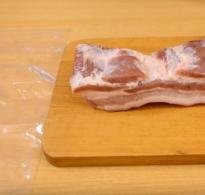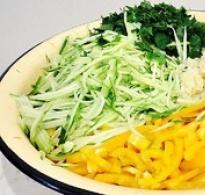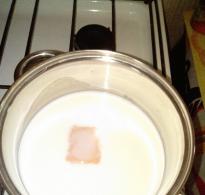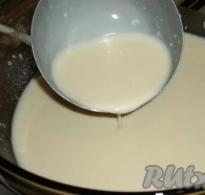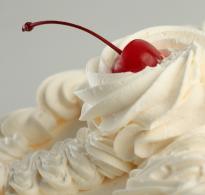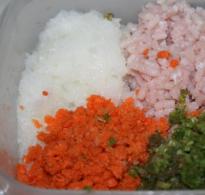Roasted chestnuts recipe. Recipes with baked chestnuts
The phrase " roasted chestnuts"First of all, it evokes thoughts of Paris, although it is unusual to taste it tasty treat It is possible in many other places in the world. The Chinese eat roasted chestnuts, and they have been doing this for many centuries; they were adored by the ancient Greeks and Romans, and they are loved by modern Europeans, Americans and Australians. In the modern world, where many boundaries are blurred, you can buy chestnuts in a supermarket in any corner of the planet. And it’s not at all difficult to fry them at home.
It should be noted that chestnuts, which grow on the streets of many cities and greatly decorate them in the spring with their candle flowers, are a decorative variety of this plant, the fruits of which are inedible. Chestnuts, which appear in our markets and stores in the fall, grow mainly in the Caucasus, Crimea, Armenia and Azerbaijan. Chestnuts from any of these regions are good if they were collected on time and stored correctly.
High-quality chestnuts are dark brown in color, they are large, heavy (if you pick up a nut, you will definitely feel it) and shiny.
How to roast chestnuts
First, they need to be peeled from the shells (if the fruits were sold with them) and washed thoroughly, preferably with a brush. Then dry on a towel and prepare a frying pan. No additional ingredients other than the fruits themselves are needed.
There are special frying pans for frying chestnuts in countries where they are common. They are usually made of cast iron or its alloys with aluminum. The only difference between chestnut pans is that they have small holes in the bottom. Not as large and not in such quantity as in a colander, but still quite often located. Chestnuts are fried in such frying pans over coals, and the holes are needed so that the fruits are saturated with smoke and acquire a specific aroma. When cooking on the stove, there is no need for such a frying pan, so a regular one will do just fine. If you have the opportunity to cook chestnuts on coals, but don’t have a frying pan, then find an old aluminum frying pan and punch holes in it, then you can try real “Parisian” chestnuts, which are cooked over wood in special roasting pans.
Chestnuts must be cut before roasting to prevent them from exploding after heating. Usually make an incision with a sharp knife crosswise, then the chestnut peel will open like a flower. You can simply make a longitudinal cut in the middle with a knife or cut off the “lid” of the chestnut, but for this you need a really sharp knife. Sometimes chestnuts are simply pierced with a fork. The main thing is to damage the shell in one way or another so that steam can escape.
So, take a frying pan, preferably cast iron, but under no circumstances Teflon, put it on the fire and lay out the chestnuts. Prepare several linen (or at least cotton) napkins or towels. Soak them in water, squeeze them out and place them on top of the chestnut layer. Fry the fruits over medium heat, remembering to lift the napkins from time to time and shake the pan so that they turn over. The wipes must be moistened as they dry. To do this, either place them under running water again and squeeze them out, or spray them with water from a spray bottle.
There is a method of frying chestnuts in which wet wipes are not used, but water is poured into the frying pan, about a centimeter, and the frying pan is covered with a lid. This method is also good, but the chestnuts will not be as crispy as when using a dry frying pan and napkins. You can roast chestnuts without using moisture, in France and Italy this is usually done, but in order for the fruits not to turn out dry and hard, they must be very fresh and filled with moisture. Ideally, freshly picked from the tree. In our conditions, this is difficult to achieve, therefore, in order not to spoil the product, it is better to use the “wet” frying method.
Chestnuts are fried for an average of 20-30 minutes, the time depends on the size of the fruit, the strength of the fire, the thickness of the pan, etc. Ready chestnuts should not only open up, but also acquire crispy crust. When it appears, remove the damp towels and dry the chestnuts for a few minutes, shaking or turning occasionally. Those who prefer salted fruits can add salt to them. Chestnuts are eaten hot, peeling them with your hands.
Recipes with chestnuts
Chestnuts are good on their own, but after trying them in pure form you might want to know the taste variety of dishes with chestnuts. Here are some options:
- Chestnut dessert: roasted nuts cleaned and filled with chocolate or coffee sauce. You can simply melt the chocolate in a water bath.
- Soup with chestnuts. Fried or boiled chestnuts, peeled and cut into slices, are added to the soup, meat or vegetarian, along with vegetables.
- Stuffing for stuffing turkey or chicken. Chestnuts, along with apples, prunes and seasonings, are placed inside the bird, sewn up and baked.
- Stew with chestnuts. The meat is stewed in the usual way, along with onions, carrots and possibly other ingredients, chestnuts are added 15-20 minutes before readiness.
Roasted chestnut prepared on the basis of a noble plant variety. You can meet it in areas with a warm climate. From what is familiar to many horse chestnut, which cannot be eaten, its noble brother is distinguished by the shape of the fruit and leaves of the tree. Chestnuts are covered with a shiny brown skin, underneath which is a wrinkled kernel (see photo). Following old recipe, chestnuts are roasted on open fire. You can add both salt and sugar to them, the final product is tasty in both cases.
Beneficial features
The benefit of roasted chestnuts lies in their low fat content compared to other nuts. The calorie content of the product is low, so consuming it in small quantities will not harm your figure. Roasted chestnut is nutritious product, thanks to the carbohydrate content. For people who do not eat meat, the vegetable protein contained in chestnuts is a real salvation.
Roasted chestnuts contain choline, which Helps normalize blood cholesterol levels. They also contain B vitamins, which restore muscle tissue and have a positive effect on work. nervous system. Contains roasted chestnut ascorbic acid, which increases protective functions in the body. Phosphorus is also found in this product, it is necessary for the restoration of bone tissue, and calcium, which is also present in edible chestnuts, is necessary to strengthen it. Roasted chestnuts contain large quantities of potassium, which has a beneficial effect on the functioning of the cardiovascular system.
Use in cooking
Such unusual product found application in cooking. Thus, in Europe, roasted chestnuts are one of the popular snacks. They are served with chocolate and numerous sweet sauces. In this case, chestnuts are an excellent dessert. In addition, they are used as a side dish served with meat. When crushed, chestnuts are suitable for preparing first courses, casseroles and salads.
How to fry chestnuts in a frying pan?
Remember that not all chestnuts are suitable for eating, but if you manage to buy required product, all that remains is to learn how to prepare it correctly. IN in this case We will fry chestnuts in a frying pan at home.
Wash the purchased chestnuts and lightly pierce each of them so that they do not explode during frying. Take a frying pan, place the chestnuts in it, and cover them with napkins on top, which need to be slightly moistened with water. Close the pan and fry the fruits over low heat for about 20 minutes. Stir the chestnuts from time to time and make sure the napkins are wet. They will be considered ready when, when pressed, the shell begins to crack and simply come off.

Secrets in chestnut recipes
Like any product, chestnut has its own subtleties and secrets in cooking recipes:
- When frying chestnuts, it is important not to overdo it, as they will become very hard and impossible to eat.
- Remove the skins from the chestnuts immediately after cooking, as this will be difficult to do after a while.
- All films and membranes must be removed from peeled chestnuts.
- It is not recommended to fry and peel a large number of chestnuts, because if you don’t eat them right away, they will become dry and tasteless.

Harm of chestnuts and contraindications
Roasted chestnuts can be harmful to people who have an individual intolerance to the product (the delicacy is contraindicated for such people). The product can also have a negative impact on those who are prone to obesity. Considering the large amount of carbohydrates, it is not recommended to overuse roasted chestnuts.
Roasting chestnuts in a frying pan - classic way preparing this dish. Later, cooks invented other cooking methods.
Preparation:
- Place the fruits in a bowl with cold water and leave for half an hour, then dry the chestnuts with paper towels and make a cross in the skin.
- Place the fruits in deep thick-walled frying pan and fill with oil, place on medium heat and fry covered for about half an hour, shaking the pan from time to time.
- Place the finished chestnuts on paper towels and cool slightly.
- Peel the fruit by lightly pressing on the skin.
Peeled chestnuts should be eaten while still warm.
How to roast chestnuts in the microwave
This method is suitable for those who want to save time.
Ingredients:
- chestnuts – 300 g;
- corn oil – 50 g.
Preparation:
- Soak the fruits in water room temperature for 15 minutes, dry with a towel and leave until the moisture has completely evaporated.
- Then pierce them with an awl in 3-4 places and place them in one layer in a deep microwave-safe container. Cover the top with a damp cloth.
- Turn on the microwave at maximum power and set the cooking time to 5 minutes. Every 1.5 minutes, pause and stir the chestnuts.
- Pour oil into the bowl and set the time for another 10 minutes. Every 2 minutes, remove the container and stir the fruits.
After roasting, transfer the chestnuts to a paper towel.
Cooking chestnuts in the oven
Ingredients:
- chestnuts – 1 kg;
- vegetable oil - for greasing the baking sheet.
Preparation:
- Soak the chestnuts for 10–15 minutes, and then dry with napkins.
- Preheat the oven to 200° and make sure that the temperature stays at this level.
- Lightly cut the flat part of the fruit.
- Grease a clean baking tray with oil and place the chestnuts on it, cut side up, in one row, leaving a little free space, sprinkle with cold water.
- Bake for about 20 minutes, moving the fruit from place to place every 1.5 minutes.
- When the peel is soft, turn off the heat in the oven.
- Cool the chestnuts slightly and peel them.
You need to peel the fruits within the first 10 minutes after turning off the oven.
Whatever cooking method you use, try not to overcook the chestnuts. Otherwise they will become very hard and tasteless.
- 1 Which chestnut can be roasted
- 2 The benefits and harms of roasted chestnuts
- 3 Chemical composition and calorie content
- 4 What do roasted chestnuts taste like?
- 5 How to fry chestnuts in a frying pan
- 6 Roasted chestnuts in the microwave
- 7 Cooking in the oven
- 8 Chestnuts roasted on charcoal
Roasted chestnuts are a rare dish today. In Russia, only residents of the Krasnodar region regularly prepare it, since it is in this region that edible fruits grow. How to fry chestnuts, and which ones are suitable for cooking, we will consider in our article.
What kind of chestnut can you roast?
The most common chestnut is horse chestnut. A tree with such fruits can be found in a variety of Russian regions. But these chestnuts are completely unsuitable for food. Moreover, it is forbidden to eat them. It is better to use them for making various crafts with children or for interior decoration.

The fruits of the following varieties of trees are suitable for preparation and consumption:
- chestnut;
- Chinese;
- Japanese.
They can only be found in regions with a warm climate and high humidity. In Russia this is the Krasnodar region. Also, such crops grow in Azerbaijan, in the south of Ukraine, Armenia, Spain, Italy, and France. Such nuts are poorly stored and have a minimum shelf life, so they rarely end up in stores in regions where they do not grow. Perhaps in fresh frozen and pickled form.
But fresh edible chestnuts are best suited for frying.
The benefits and harms of roasted chestnuts
The unique composition of edible chestnuts makes them very beneficial for the human body, and low calorie content(unlike other nuts) also allows you to add the product to your diet dietary nutrition. Chestnuts are also ideal for vegetarian menus. High content vegetable protein in the composition allows them to some extent replace meat in the human diet.

Roasted chestnuts have the following beneficial effects on the body:
- improve the condition of blood vessels (eating such nuts is especially useful for varicose veins);
- reduce and normalize the level of “bad” cholesterol in the blood;
- normalize the functioning of the nervous system;
- heal and strengthen bone tissue, promote its natural recovery after injuries;
- strengthen the immune system;
- normalize the functioning of the gastrointestinal tract;
- increase endurance.
But we must not forget that there is a very big difference between the benefits and harms of the product under discussion. a fine line. Therefore, you should not abuse such treats in fried. For example, very large portions dishes can negatively affect your figure. Some people who are losing weight, having learned that this type of nut is one of the lowest in calories, begin to eat them huge quantities. In this case, any diet will be in vain.
Roasted chestnuts are prohibited for consumption by people with severe pathologies of the heart, blood vessels, gastrointestinal tract and blood diseases.
Particular care should be taken when introducing them into the diet of women in an “interesting” position, nursing mothers and small children.
Chemical composition and calorie content
As noted above, the calorie content of such fried nuts turned out to be small. It is only 247.3 kcal per 100 g finished product. Carbohydrates predominate in its composition - more than 50 g per 100 g of product.

Of the microelements, the treat under discussion contains a large amount of potassium and iron, as well as calcium, phosphorus, and many B vitamins (including folic acid), vitamins C, E, K, PP, A, beta-carotene.
Separately, it is worth noting fatty acids and amino acids. Among the former: omega-3 and omega-6, among the latter: leucine, lysine, arginine, valine and others.
What do roasted chestnuts taste like?
Properly selected and prepared roasted chestnuts have pleasant taste. They resemble nuts (mostly peanuts) or seeds prepared in the same way. The taste of the dish may differ slightly depending on the variety of chestnuts and the cooking method.



Some gourmets note that the fruits cooked over charcoal are reminiscent of potatoes fried in a fire with a sweetish aftertaste.
How to fry chestnuts in a frying pan

Ingredients:
- chestnut nuts – 1 kilo;
- any vegetable oil – ½ l.
Preparation:
- Before frying chestnuts in a frying pan, the container must be filled almost to the top with high-quality refined vegetable oil.
- When the fat warms up well, you can put the fruits in it. It is very important to first cut each one slightly or simply pierce it with a fork.
- Cover the parts of the chestnuts protruding from the oil with paper towels and periodically moisten them in fat so that the fruits do not dry out.
- Cover the container with a lid. Cook the contents of the frying pan for half an hour over medium-low heat. Shake the nuts periodically without removing the lid.
Serve the finished treat, sprinkled with salt or granulated sugar.
Roasted chestnuts in the microwave
To implement such a simple and fast way When preparing chestnuts, they also need to be cut so that a hole appears for steam to escape.

Ingredients:
- chestnuts – 1 kg;
- hot water – 5 tbsp. l.;
- salt - to taste.
Preparation:
- Place the prepared fruits in a wide bowl with low sides, suitable for microwave oven.
- Pour on top hot water. Add salt to the fruit to taste.
- Close the container with a lid. A glass plate is not suitable for this purpose! If you don’t have a suitable cover at hand, you can take film.
- Cook the dish for 8 minutes at maximum power of the device.
Cooking in the oven
This method of cooking chestnuts allows you to make a treat less calorie than when frying in a large amount of oil. And the fruits are perfectly baked in the process.

Ingredients:
- chestnuts – 1 – 2 kg.
Preparation:
- Preheat the oven to 180 - 190 degrees.
- Make a cut on each chestnut or pierce the fruit with a fork so that they do not explode during baking.
- Place the pieces on a baking sheet in one layer. Do not cover with anything!
- Place the chestnuts in this form in the oven for 35 - 40 minutes.
- Serve the finished treat to the table.
Peeled chestnuts cooked in the oven can be used as the basis of a salad. The ideal dressing for a snack with them would be olive oil with freshly squeezed citrus juice and spices.
Chestnuts roasted on charcoal
It is very convenient to cook chestnuts outdoors. For example, on coals. But for this method of preparing them, you will need to arm yourself with a frying pan with a hole in the bottom.

Ingredients:
- raw chestnuts - 1 serving.
Preparation:
- Properly frying chestnuts according to this recipe should be done on previously prepared coals. A special frying pan with a hole in the bottom is placed on top of them.
- Chestnuts are poured into the container. Be sure to lay them in just one layer, otherwise the fruits will remain damp for a very long time. In advance, their skin must be cut through with a sharp knife to the white layer.
- Fry chestnuts without oil in a frying pan with holes for 15 - 17 minutes. Shake the container constantly during the process to prevent the fruits from burning.
The heat should not come close to the chestnuts. They are cooked by the heat of coals, not an open flame.
Regardless of which method of frying chestnuts is chosen, the dish will only be truly tasty immediately after cooking. When the delicacy has cooled down or been completely cool for several hours, it taste qualities will worsen significantly. Therefore, you should try the treat only when it is freshly prepared.
The beautiful plant - chestnut - is familiar only to a certain part of the world's population, since due to its natural characteristics it can grow and reproduce only in special climatic conditions. But despite this, roasted chestnuts today can be tasted in any part of the world. It will not be difficult for travel lovers to find at least one establishment in any city in Europe, Asia, America and the countries of the former post-Soviet space, where they would not treat you to this delicacy or show you how to roast chestnuts.
What's good about chestnuts?
The chestnut belongs to the beech genus, but there are only a few edible species that can be eaten.
If you choose the wrong type of chestnut for food, you can seriously harm your health.
Mineral composition edible type this plant includes:
- starch;
- carbohydrates;
- protein;
- cellulose;
- tannins;
- beta-carotene;
- vitamins A, C and group B.
The energy value of chestnut is 170 kcal per 100 g of product. In addition, roasted chestnuts, the benefits of which also include a number of useful substances- potassium, phosphorus, magnesium, calcium, manganese and selenium are in great demand as components diet menu product. The fats and proteins that chestnuts contain make them very nutritious and especially popular among athletes.
The benefits of chestnuts in the treatment of upper respiratory tract, for hemorrhoids, varicose veins, leg fatigue and swelling. Roasted and baked chestnuts should not be consumed by people with gastrointestinal diseases, patients diabetes mellitus and those who have problems with blood, as well as those who care about their figure.
In my own way appearance Edible and decorative chestnuts do not differ from each other in external characteristics.
How to roast chestnuts correctly
 Due to the popularity of this special product, many are interested in how to roast chestnuts at home. To begin with, you should choose from the available chestnut fruits that are not spoiled, good quality. To check which of them can be eaten, you need to fill them with water. Those chestnuts that float should be removed, and those that settle to the bottom can be cooked.
Due to the popularity of this special product, many are interested in how to roast chestnuts at home. To begin with, you should choose from the available chestnut fruits that are not spoiled, good quality. To check which of them can be eaten, you need to fill them with water. Those chestnuts that float should be removed, and those that settle to the bottom can be cooked.
There is a standard method for roasting chestnuts at home, the recipe for which is as follows:
- Before frying the fruits, you need to pierce them in several places with a fork or cut them. This will prevent them from exploding.
- The chestnuts are placed in a deep frying pan filled with oil, and several wet wipes are placed on top of them. This is one of the tricks on how to roast chestnuts at home so that they are not hard and dry. The frying pan must be covered with a lid - this is another feature of how to properly fry chestnuts. If the chestnuts start to burst and explode, then they will not jump out of the pan.
- How long to fry chestnuts should not exceed 30 minutes. Periodically during frying, chestnuts should be shaken with the lid closed.
- The finished dish is lightly salted and served cooled.
Roasted chestnuts, the recipe for which is described above, is a classic way of preparing them, which resembles the taste of this dish offered in some countries - France, Spain and others right on the street. The above method shows how to fry chestnuts in a frying pan. But there are other ways that suggest doing this in the oven or even on an open fire, on a campfire during a picnic.
Before frying chestnuts, you should take into account that the edible type is much smaller in size than horse chestnuts, and also has a flat surface on one side. Roasted chestnuts, the recipe for which involves soaking them, can be easily peeled after cooking - you just need to press on them from above and they will begin to crack and peel.
It is better to peel the chestnuts right away, as it will be much more difficult to do later.
Knowing how to fry chestnuts in a frying pan, you can cook a large number of dishes with them. Roasted chestnuts are often used as an addition to salads, additional ingredient for meat and fish dishes.
Recipes with baked chestnuts
At home, you can prepare delicious baked chestnut fruits. We offer a recipe on how to roast chestnuts in the oven without spending a lot of time. To do this, chestnuts in the amount of 20 pieces, which are placed in a preheated oven, are baked for 35 minutes. They are cleaned while still warm.
Since you can bake chestnuts in the oven at home even before guests arrive, this will be a pleasant surprise especially for those who love unusual and exotic dishes. Baked chestnuts can be added to salads and other types of dishes. We offer a recipe for one of the salads with baked chestnuts, which is prepared according to the following principle:
- Peel the chestnuts baked in the oven, add arugula, cherry tomatoes, Bell pepper and incompletely cooked durum pasta.
- The sauce is prepared separately - olive oil is mixed with lemon juice.
- The ingredients are mixed and seasoned with sauce.
Vegetarian roast with chestnuts
 This dish is popular among people who do not eat meat - vegetarians. Protein, which predominates in chestnut fruits and mushrooms, can replace meat. The method of preparing this dish is completely easy and will not take much time from the hostess.
This dish is popular among people who do not eat meat - vegetarians. Protein, which predominates in chestnut fruits and mushrooms, can replace meat. The method of preparing this dish is completely easy and will not take much time from the hostess.
Preparation
- Mushrooms are fried and stewed with the addition of cognac until the liquid has completely evaporated.
- Chestnuts are cleaned and crushed with hazelnuts.
- On olive oil fry garlic and onion. Add caraway seeds and thyme.
- All contents are mixed and placed in a mold, adding a little water.
- Place the dish in the preheated oven and bake for about 40 minutes.
Chestnuts in milk

For this dish you will need:
- chestnuts - 500 g;
- milk - 0.5 l;
- sugar (honey) - 2 tbsp. l.;
- cinnamon - 1 pc.
Ingredients
Preparation
- Peel fresh chestnuts.
- Boil chestnut kernels in water for several minutes, then peel off the film.
- Place the kernels in milk and add sugar or honey and a cinnamon stick.
- Place the container with milk and chestnuts on water bath and simmer over low heat for 30 minutes until the chestnuts soften.
This wonderful dessert will delight lovers of roasted and baked chestnuts with its unusual taste and original preparation.

